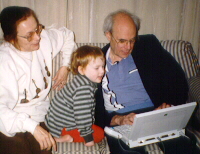Mathematics After AD 2000
Today, let's teach math to our grandchildren. The University of Houston's College of Engineering presents this series about the machines that make our civilization run, and the people whose ingenuity created them.
We face pedagogical trouble today. Every time I speak to an audience, I get the question, "How do we fight sagging math abilities in our schools?" So first, let's try to understand the problem. You and I did many things in school that students no longer have to do. We memorized poetry. We plotted graphs. We did arithmetic in our heads. Books and radio were our entertainment.
Now the new electronic media pick up so many of those functions. They remember for us. Not only do they do the arithmetic, they solve differential equations and they plot the graphs.
Just now I saw a TV spot about special effects in the movie, Anaconda. A woman said, "Because of computer graphics we can do so much more. We can open up the imagination." But when she makes an oversize serpent materialize, that does less to open our imaginations than it does to show us her imagination.
Consider how that works in teaching. We teachers once memorized poetry, plotted graphs, did mental arithmetic, imagined dragons, invented solutions to calculus problems. But our students have not. We're trying to share the hard-earned fruits of our own imagination and memory. Students have calculators (as we do), computers (as we do), and TV sets (as we do.) But they lack our experience of life without those things. All this high-tech is one thing to us. It's something else entirely to them.
It's a delight for us when the computer creates conic sections on the screen that look just like objects we once visualized in our minds. But the student who's seen them only on a screen is baffled when we ask him to sketch diagonal sections of, say, an airplane fuselage or a human skull -- items that don't happen to be stored in the computer.
It's a delight for me when the computer hands me the context of Shakespeare's line, "My library was dukedom large enough." Prospero said that to his daughter in The Tempest. He said it in praise of the inner life he now led in his private island world. But for students who never remembered the line in the first place, the computer's ability to find it is quite empty.
So we teachers face a formidable task. First we have to reduce the two-dimensional screen back to its proper role as a tool. It belongs in the background. Then we have to find new means for training the mind when we have at hand a machine that can replace so much of the mental exercise you and I used to grow strong.
We teachers and parents need to forget the novelty of our computers. After all, they'll be as ordinary to our children as the new cars and electricity were in our lives. We need to find ways to walk around our two-dimensional screens -- and to take our children back to Prospero's rich three-dimensional island of the mind.
I'm John Lienhard, at the University of Houston, where we're interested in the way inventive minds work.
(Theme music)

A Kid and a Computer
(Photo © Theresa Kavanaugh-Lienhard)